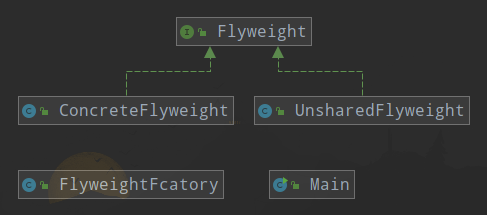运用享元模式(Flyweight)可以有效地支持大量细粒度的对象。
类结构

代码
package com.elltor.designpattern.Flyweight;
public interface Flyweight {
void operation(int i);
}
package com.elltor.designpattern.Flyweight;
public class ConcreteFlyweight implements Flyweight {
@Override
public void operation(int i) {
System.out.println("具体的享元对象: "+i);
}
}
package com.elltor.designpattern.Flyweight;
import java.util.HashMap;
public class FlyweightFcatory {
private HashMap<String,ConcreteFlyweight> flyweightMap = new HashMap<>();
public FlyweightFcatory() {
flyweightMap.put("A",new ConcreteFlyweight());
flyweightMap.put("B",new ConcreteFlyweight());
flyweightMap.put("C",new ConcreteFlyweight());
flyweightMap.put("D",new ConcreteFlyweight());
flyweightMap.put("E",new ConcreteFlyweight());
}
public Flyweight getFlyweight(String key){
return flyweightMap.get(key);
}
}
package com.elltor.designpattern.Flyweight;
public class UnsharedFlyweight implements Flyweight {
@Override
public void operation(int i) {
System.out.println("不被共享的享元对象: "+i);
}
}
package com.elltor.designpattern.Flyweight;
public class Main {
public static void main(String[] args) {
int i = 100;
FlyweightFcatory factory = new FlyweightFcatory();
Flyweight flyweightA = factory.getFlyweight("A");
flyweightA.operation(i);
Flyweight flyweightB = factory.getFlyweight("B");
flyweightB.operation(i*2);
Flyweight flyweightC = factory.getFlyweight("C");
flyweightC.operation(i*3);
Flyweight flyweightD = factory.getFlyweight("D");
flyweightD.operation(i*4);
Flyweight flyweightE = factory.getFlyweight("E");
flyweightE.operation(i*5);
}
}
//打印结果
具体的享元对象: 100
具体的享元对象: 200
具体的享元对象: 300
具体的享元对象: 400
具体的享元对象: 500
抽离表象, 用同一个对象表示不同"外观"的对象, 这些"外观"的差异是由数据的不同而产生。